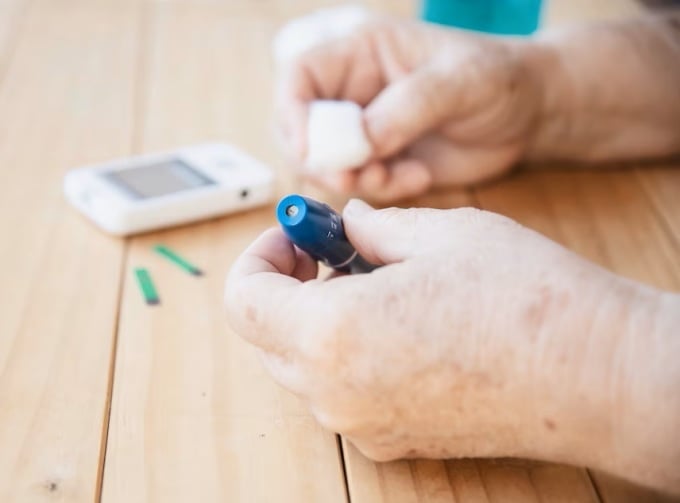There are many ways to prevent ketoacidosis, which causes acid to build up in the blood, such as: managing diabetes, monitoring blood sugar, and adjusting insulin levels when necessary.
Dr. Vo Tran Nguyen Duy (Department of Endocrinology - Diabetes, Tam Anh General Hospital, Ho Chi Minh City) said that ketoacidosis is the accumulation of acid in the patient's blood, which occurs when blood sugar levels are too high and last for too long. The disease is common in people with type 1 diabetes and less common in people with type 2 diabetes.
Ketoacidosis is a serious and potentially life-threatening complication. Ketoacidosis can be treated and prevented by controlling blood sugar levels. Diabetics can prevent ketoacidosis by:
Diabetes management: Patients should maintain a healthy diet and regular daily physical activity, and take diabetes medications or insulin as directed by their doctor.
Monitor your blood sugar: You should check and record your blood sugar at least 3-4 times a day, and more often if you are dealing with another illness or are stressed. Close monitoring helps you make sure your sugar levels stay stable.
Adjusting insulin dosage as needed: Patients should discuss with their doctor if they intend to adjust their insulin dosage to suit themselves. Factors to consider include blood sugar levels, foods, and activity levels. If blood sugar levels begin to rise, you should follow your doctor's advice and treatment plan to bring your blood sugar levels back to a stable level.
Recognize and treat promptly: If you think you have ketoacidosis, you need to see a doctor immediately.
Dr. Nguyen Duy further explained that the body of a diabetic does not produce enough insulin or does not use insulin effectively. Insulin is produced by the pancreas and plays an important role in "connecting" blood sugar to cells to nourish the body. Without enough insulin, the body begins to break down fat for fuel, causing a buildup of acids in the blood called ketones. If this condition is left untreated, the buildup of acids leads to ketoacidosis.
People with diabetes should not ignore the warning signs of ketoacidosis such as thirst and frequent urination. Symptoms of diabetic ketoacidosis progress rapidly, sometimes within 24 hours, and include: rapid and deep breathing; dry skin and mouth; flushed face; fruity breath odor; headache; muscle stiffness or pain; fatigue, nausea, vomiting, and abdominal pain. Sometimes ketoacidosis is a sign of diabetes in people who have not been diagnosed with the disease.

Diabetics should check and record their blood sugar levels at least 3-4 times a day. Photo: Freepik
Doctor Nguyen Duy pointed out two main factors causing this condition in diabetics including:
Other illnesses: People with diabetes have poor appetites and are more likely to skip meals, making it difficult to control blood sugar levels. People with infections or severe illnesses produce more hormones such as adrenaline or cortisol. These hormones work against the effects of insulin, causing ketoacidosis. Pneumonia and urinary tract infections are common illnesses that lead to ketoacidosis.
Insulin therapy: Diabetics are prescribed insulin injections but for some reason forget to inject, inject an insufficient dose, or use the wrong dose of insulin, all of which can lead to ketoacidosis.
Other causes include heart attack or stroke; physical trauma such as a car accident or emotional trauma; alcohol or drug abuse. Use of certain medications such as diuretics and corticosteroids; pancreatitis; pregnancy can also lead to this condition.
Ketoacidosis is a serious problem that occurs in people with diabetes. Therefore, when there are symptoms of ketoacidosis, patients need to go to the nearest medical facility for timely treatment to avoid complications.
Quynh Dung
Source link



![[Photo] General Secretary To Lam receives King Philippe of Belgium](https://vstatic.vietnam.vn/vietnam/resource/IMAGE/2025/4/1/e5963137a0c9428dabb93bdb34b86d7c)
![[Photo] Close-up of Vietnam's sniffer dog team searching for earthquake victims in Myanmar](https://vstatic.vietnam.vn/vietnam/resource/IMAGE/2025/4/1/d4949a0510ba40af93a15359b5450df2)

![[Photo] President Luong Cuong and King Philippe of Belgium visit Thang Long Imperial Citadel](https://vstatic.vietnam.vn/vietnam/resource/IMAGE/2025/4/1/cb080a6652f84a1291edc3d2ee50f631)
![[Photo] Prime Minister Pham Minh Chinh meets with King Philippe of Belgium](https://vstatic.vietnam.vn/vietnam/resource/IMAGE/2025/4/1/be2f9ad3b17843b9b8f8dee6f2d227e7)

























![[Photo] Myanmar's capital in disarray after the great earthquake](https://vstatic.vietnam.vn/vietnam/resource/IMAGE/2025/4/1/7719e43b61ba40f3ac17f5c3c1f03720)






























































Comment (0)